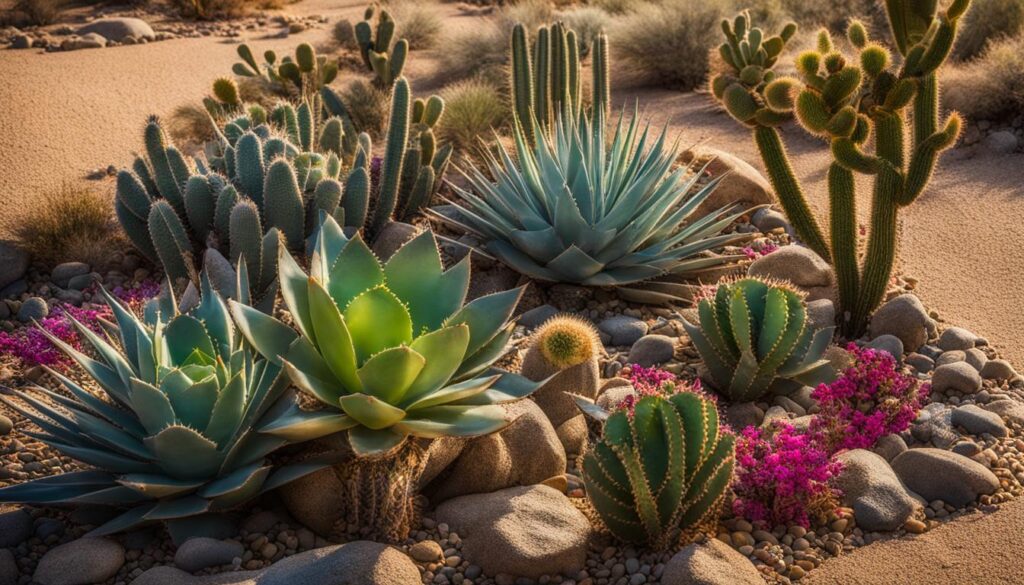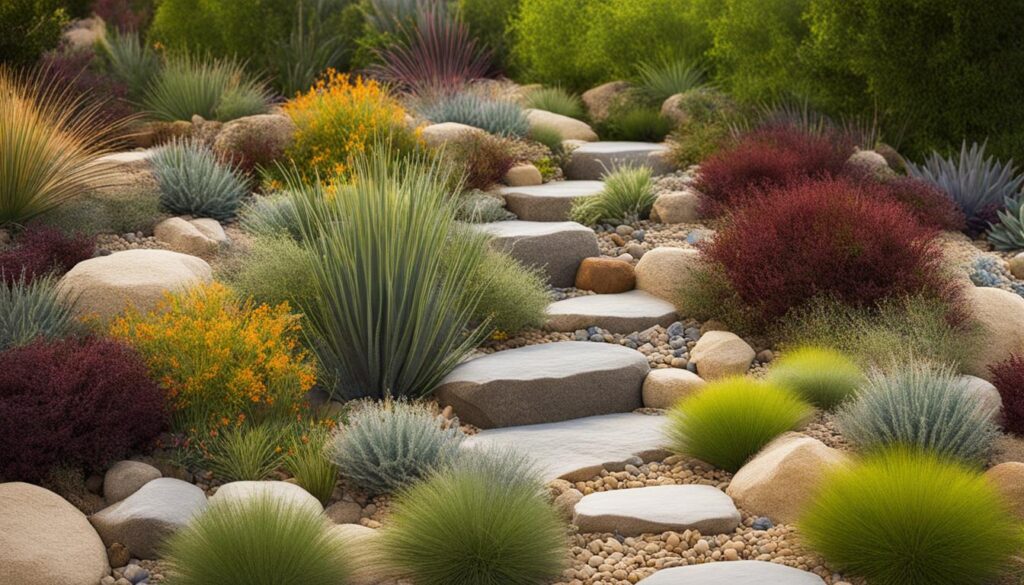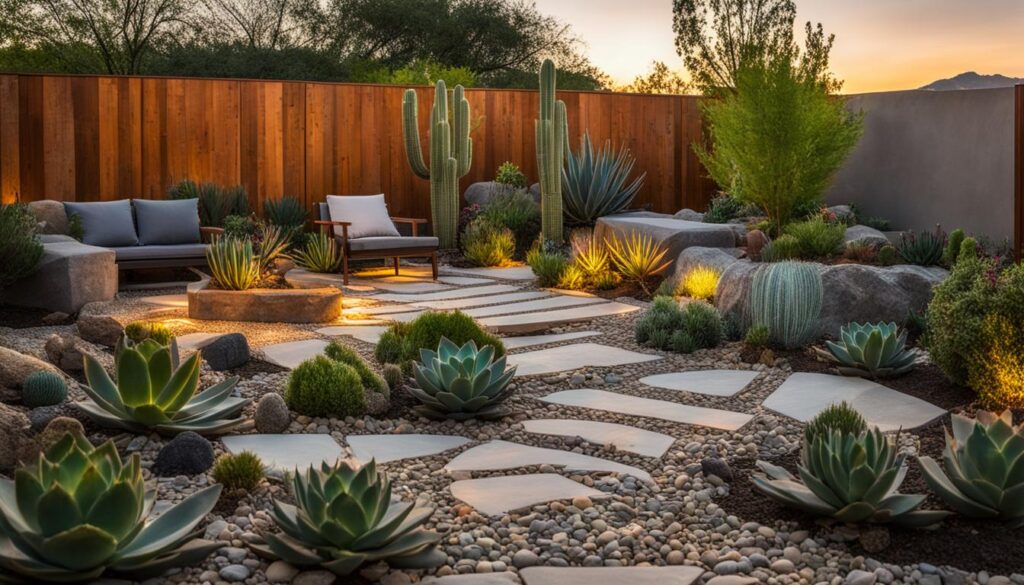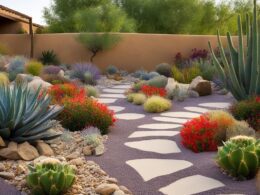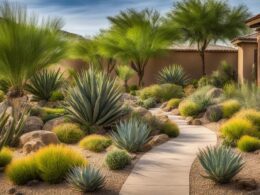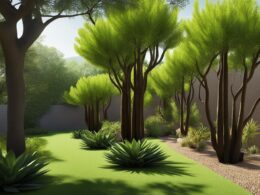Planning an eco-friendly and water-efficient yard involves strategic considerations to create a xeriscape landscape. With careful planning and implementation, you can transform your yard into a sustainable oasis that conserves water and reduces maintenance requirements.
Key Takeaways:
- Xeriscape landscaping focuses on creating a low-water and eco-friendly yard.
- Efficient irrigation and drought-tolerant plants are essential for water conservation.
- There are seven principles of xeriscaping that guide the design and maintenance process.
- Residents in drought-prone areas can benefit greatly from xeriscape landscaping.
- The cost of xeriscaping can vary, but DIY options are more budget-friendly.
What Is Xeriscaping?
Xeriscaping is a landscaping method that focuses on reducing water usage and maximizing water conservation. It involves using drought-tolerant plants, efficient irrigation systems, and soil improvements to create a low-water landscape. Xeriscaping is beneficial for both the environment and homeowners, as it can significantly reduce water needs and maintenance requirements.
By incorporating xeriscape principles into your yard, you can create a beautiful and eco-friendly landscape that thrives even in dry conditions. Drought-tolerant plants, such as succulents, native grasses, and cacti, are key elements of xeriscaping. These plants have adapted to arid environments and require minimal watering, making them ideal for water conservation.
To further conserve water, xeriscaping utilizes efficient irrigation systems, such as drip irrigation or soaker hoses, which deliver water directly to the roots of plants. This reduces water evaporation and wastage. Additionally, soil improvements, such as adding organic matter and mulching, help retain moisture in the soil, reducing the need for frequent watering.
Xeriscaping Benefits:
- Reduces water usage
- Minimizes maintenance requirements
- Creates a sustainable and eco-friendly landscape
- Promotes the health of native wildlife
- Saves money on water bills
“Xeriscaping helps homeowners create a beautiful and water-efficient landscape that is both environmentally friendly and cost-effective.”
Whether you live in a region prone to drought or simply want to reduce your water usage, xeriscaping offers a practical solution. By implementing xeriscape principles in your yard, you can create a visually appealing landscape that conserves water, minimizes maintenance, and supports the local ecosystem.
The 7 Principles of Xeriscaping
Creating a water-efficient and low-maintenance yard is made possible by following the seven principles of xeriscaping. By incorporating these principles into your landscaping design, you can create a beautiful and eco-friendly space while conserving water.
1. Planning and Design
Before starting your xeriscape project, take the time to plan and design your yard. Evaluate your space, consider the amount of sunlight it receives, and identify any problem areas that may require specific solutions. By carefully planning, you can optimize your yard’s water usage and ensure a cohesive and attractive design.
2. Soil Improvements
Preparing your soil is essential for successful xeriscaping. This can involve improving soil structure and composition by adding organic matter, such as compost, to increase water retention and drainage. Proper soil preparation promotes healthy root growth and helps plants thrive in drier conditions.
3. Efficient Irrigation
Efficient irrigation systems are key to conserving water in a xeriscape yard. Consider installing drip irrigation or low-flow sprinkler systems that deliver water directly to the plant’s roots, reducing evaporation and runoff. Smart irrigation controllers can also help regulate watering schedules based on weather conditions, further optimizing water usage.
4. Plant Zones
Dividing your yard into plant zones based on water needs is another important aspect of xeriscaping. Place plants with similar water requirements together, creating microclimates that allow for efficient watering. This zoning strategy ensures that each plant receives the appropriate amount of water, preventing overwatering or underwatering.
5. Mulching
Mulching is a crucial practice in xeriscaping as it helps conserve water, suppresses weeds, and regulates soil temperature. Apply a layer of organic mulch, such as wood chips or bark, around your plants to reduce evaporation and maintain moisture in the soil. Mulch also adds aesthetic appeal to your yard.
6. Turf Alternatives
Consider replacing traditional lawns with low-water alternatives in your xeriscape yard. Options like native grasses, groundcovers, or hardscape features such as gravel or pavers can significantly reduce water usage and maintenance. These alternatives can create visually appealing and functional spaces while conserving water.
7. Maintenance
Maintaining your xeriscape yard involves regular tasks such as adjusting irrigation schedules, removing weeds, and monitoring plant health. By properly maintaining your xeriscape, you can ensure the continued success and beauty of your water-efficient and low-maintenance landscape.
Who Benefits From Xeriscaping?
Xeriscaping is a landscaping technique that offers numerous benefits, especially in drought-prone areas. Implementing xeriscape principles in your yard can help you conserve water, save money, and support the health of local ecosystems. Whether you reside in California, Arizona, Nevada, Colorado, or any other region affected by water scarcity, xeriscaping can be a game-changer.
By incorporating xeriscape landscaping, you can significantly reduce your water usage. Drought-tolerant plants, such as succulents, cacti, and native grasses, require less water compared to traditional turf. This not only helps conserve precious water resources but also lowers your monthly water bills. With xeriscaping, you can enjoy a lush and vibrant yard while using significantly less water.
In addition to water conservation, xeriscaping promotes the health of local ecosystems. By planting native and drought-tolerant plants, you create a habitat that supports local wildlife, including birds, butterflies, and pollinators. Xeriscape yards provide food, shelter, and nesting sites for these important species, contributing to the overall ecological balance in your area.
Another advantage of xeriscaping is its low maintenance requirements. With drought-tolerant plants and efficient irrigation systems, you’ll spend less time mowing, watering, and maintaining your yard. Xeriscape landscaping is designed to thrive in the local climate, reducing the need for constant care and maintenance. This gives you more time to relax and enjoy your outdoor space without the hassle of high maintenance tasks.
Overall, xeriscaping benefits not only homeowners but also the environment. By conserving water, supporting local ecosystems, and reducing maintenance needs, xeriscape yards are a sustainable and eco-friendly landscaping choice. Whether you live in a drought-prone area or simply want to contribute to water conservation efforts, xeriscaping is a smart and responsible solution.
How Much Does Xeriscaping Cost?
When considering xeriscaping for your yard, one important factor to consider is the cost. The cost of xeriscaping can vary depending on several factors, including the size of your yard and whether you choose to hire a professional or do the work yourself. On average, professional xeriscape landscaping can cost around $5 to $20 per square foot. This cost includes the design, installation, and materials needed for your xeriscape yard.
However, if you’re working with a limited budget, DIY xeriscaping can be a more budget-friendly option. By doing the work yourself, you can save on labor costs and have more control over the materials used. DIY xeriscaping projects can range from simple to complex, depending on your skills and preferences. You can start small by incorporating drought-tolerant plants and efficient irrigation systems, then gradually expand and enhance your xeriscape yard over time.
It’s worth noting that in certain areas, there are options for applying for turf replacement rebates, which can help offset the cost of xeriscape installations. These rebates are often offered by local water agencies or municipalities as an incentive for homeowners to replace traditional lawns with water-saving landscapes. The rebates can help make xeriscaping more accessible and affordable for homeowners who are looking to conserve water and save money on their water bills.
Remember, the cost of xeriscaping is an investment in the long-term sustainability and beauty of your yard. By reducing water usage and maintenance requirements, xeriscaping can save you money in the long run and contribute to a more eco-friendly landscape. Whether you choose to hire a professional or take on a DIY project, xeriscaping offers a cost-effective and environmentally conscious solution for creating a beautiful, budget-friendly, and sustainable yard.
Is There a Specific Method for Planning a Xeriscape Yard Versus a Xeriscape Plan for Backyards?
When it comes to xeriscape backyard plan creation, the approach may differ from planning a xeriscape yard. While both aim to conserve water and use drought-resistant plants, a backyard plan should consider factors like space utilization, privacy, and creating a relaxing outdoor oasis.
Conclusion
Planning a xeriscape yard is a wise choice for homeowners looking for water-saving and sustainable landscaping solutions. By incorporating the principles of xeriscaping, such as efficient irrigation, drought-tolerant plants, and soil improvements, you can create a beautiful and eco-friendly landscape that conserves water.
With a xeriscape yard, you can significantly reduce your water usage, which not only helps the environment but also lowers your water bills. The low maintenance requirements of xeriscaping make it an appealing option for busy homeowners, as it minimizes the time and effort needed to keep your yard looking its best.
Whether you live in a drought-prone area or simply want to be more conscious of your water usage, xeriscaping offers a sustainable landscaping solution. By embracing a xeriscape yard, you can enjoy a vibrant and thriving outdoor space while contributing to water conservation efforts and promoting a more sustainable future.






